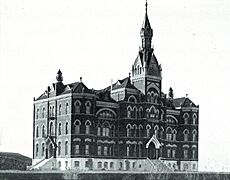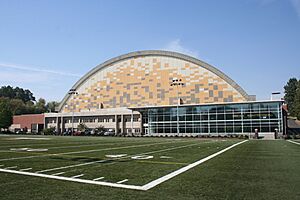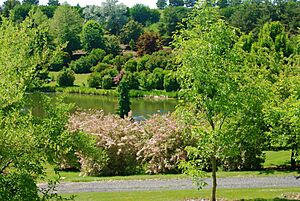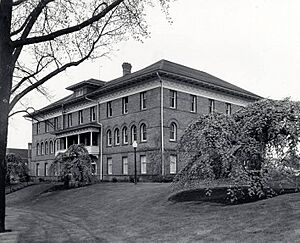University of Idaho facts for kids
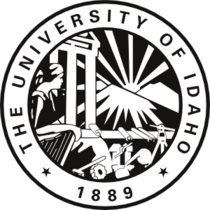 |
|
| Motto | "A Legacy of Leading" |
|---|---|
| Type | Public land-grant research university |
| Established | January 30, 1889 |
|
Parent institution
|
Idaho State Board of Education |
| Accreditation | NWCCU |
|
Academic affiliations
|
Space-grant |
| Endowment | $465 million (2023) |
| President | C. Scott Green |
| Students | 11,849 (Fall 2023) |
| Undergraduates | 9,796 (Fall 2023) |
| Postgraduates | 1,929 (Fall 2023) |
| Location |
,
,
United States
46°43′34″N 117°00′40″W / 46.726°N 117.011°W |
| Campus | Distant town, 1,585 acres (6.4 km2) |
| Other campuses | |
| Newspaper | The Argonaut |
| Colors | Silver and vandal gold |
| Nickname | Vandals |
|
Sporting affiliations
|
NCAA Division I FCS – Big Sky |
| Mascot | Joe Vandal |
 |
|
The University of Idaho (U of I, or UIdaho) is a public land-grant research university in Moscow, Idaho. It is the state's land-grant and primary research university, and the lead university in the Idaho Space Grant Consortium. The University of Idaho was the state's sole university for 71 years, until 1963. Its College of Law, established in 1909, was first accredited by the American Bar Association in 1925.
It has an enrollment exceeding 12,000, with over 11,000 on the Moscow campus. The university offers 142 degree programs, from accountancy to wildlife resources, including bachelor's, master's, doctoral, and specialists' degrees, and accompanying honors programs. Certificates of completion are offered in 30 areas of study. At 25% and 53%, its 4 and 6 year graduation rates are the highest of any public university in Idaho, and it generates 74 percent of all research money in the state, with research expenditures of $100 million in 2010 alone. It is classified among "R2: Doctoral Universities – High research activity".
As a land-grant university and the primary research university in the state, U of I has the largest campus in the state at 1,585 acres (2.5 sq mi; 6.4 km2), in the rolling hills of the Palouse region at an elevation of 2,600 feet (790 m) above sea level. The school is home to the Idaho Vandals, who compete in NCAA Division I athletics. In addition to the main campus in Moscow, the U of I has branch campuses in Coeur d'Alene, Boise, and Idaho Falls. It also operates a research park in Post Falls, and dozens of extension offices statewide.
Contents
History
On January 30, 1889, Governor Edward Stevenson of the Idaho Territory signed the territorial legislature's Council Bill No. 20, which officially established the UI as the upcoming state's land-grant institution. Nearly four years later, the university opened for classes on October 3, 1892. The choice of location for the University of Idaho was an "Olive Branch of Peace" by Gov. Stevenson for his actions in styming the nearly successful effort to detach the north Idaho Panhandle and join the state of Washington.
Formed by the Idaho Territory legislature in 1889, the university opened its doors in 1892 with a class of 40 students. The first graduating class in 1896 consisted of two men and two women.
In 2023 the University of Idaho established a non-profit organization, Four Three Education, which would acquire the University of Phoenix by issuing $550 million in bonds (creating an estimated $685 million in debt). Idaho spent approximately $7 million on consultants prior to the deal. Three University of Idaho administrators sit on the Four Three board, including UI attorney Kent Nelson. The slate of directors of Four Three Education will be selected by the Regents of the University of Idaho. However, President Green and University of Phoenix President Chris Lynne will be "ex-officio members with full voting rights."
Campus
According to the U of I Facts Books, the Moscow campus, abutting the Washington state line, is 1,585 acres (2.5 sq mi; 6.4 km2), including 253 buildings with a replacement value of $812 million. It has 49 acres (20 ha) of parking lots, 1.2 miles (2 km) of bike paths, 22 computer labs, an 18-hole golf course on 150 acres (61 ha), 80 acres (32 ha) of arboreta, and 860 acres (1.3 sq mi; 3.5 km2) of farms.
Administration Building
The Administration Building, with its eighty-foot (24 m) clock tower and Collegiate Gothic-style structure, was built from 1907 to 1909 and has become an icon of the university. The building holds classrooms, an auditorium, and administrative offices, including the offices of the President and Provost. Multiple expansions were made, with the north wing added in 1912, the eastern portion of the south wing in 1916 (extended west in 1936 for the library), and the functional annex in 1950, incorporated into the Albertson addition of 2002. The U of I library was housed in the Administration building until 1957, when the Library building opened, constructed on the former site of tennis courts. The College of Law occupied the south wing until its building (Menard) opened in 1973.
The original Administration building, with a single tall spire reaching to 163 feet (50 m), was constructed through the decade of the 1890s and ultimately finished in 1899. It burned in 1906. In the meantime, classes were held at various sites in Moscow. The new Administration building was designed by John E. Tourtellotte, who modeled the new structure after Hampton Court Palace in England.
The 1909 Administration building was added to the National Register of Historic Places in 1978. Two years out of office, former U.S. president Theodore Roosevelt spoke outside the main east entrance of the new building on April 9, 1911, on a platform built of Palouse wheat.
Hello Walk
"Hello Walk" is one of the best-known and traveled pathways on the Idaho campus. It includes monuments such as Presidential Grove, where historical figures, such as Teddy Roosevelt, planted trees; the Spanish–American War memorial statue who had his hands cut off but was reconstructed by the handless sculptor Bud Washburn; and Administration Lawn that was designed by the Olmsted Brothers.
Idaho Student Union Building
The Idaho Student Union Building, (ISUB) completed in 2000 as the Commons, is the heart of campus and contains a food court, copy center, bagel and coffee shop (Einstein's Bagels), Credit Union, and convenience store. Additionally, there is study space, wireless internet, laptop checkout, and many student services such as the offices of the Associated Students of the University of Idaho (ASUI), Academics Assistance, the University of Idaho Writing Center, and Student Support.
With the completion of the Teaching and Learning Center (TLC) at the beginning of the fall semester of 2005, the second phase, the Idaho Student Union Building gained classrooms and completed the vision of a common area where students could learn, study, relax, and get university services all in one place.
Bruce M. Pitman Center
The Bruce M. Pitman Center is located on the east end of campus on Deakin Street. The building houses the university's financial aid, admissions, new student services, registrar and Graduate & Professional Student Association (GPSA) offices. For students, the Pitman Center also features meeting rooms, a computer lab, wireless access, borrowable laptops and a movie theater. The building began as a motel, the Blue Bucket Inn, which UI purchased in 1936 and later expanded. The VandalStore, built in 1989 on a former parking lot, is located directly across the street to the east; it was previously adjacent to the south.
UI student-run media offices are also present on the third floor of the Pitman Center: The Argonaut, a newspaper; KUOI-FM, a radio station; student media advertising; and Blot, a magazine.
In October 2014, the University of Idaho announced the renaming of the Student Union Building as Bruce M. Pitman Center in honor of the retiring dean of students and vice provost for student affairs, who had served the campus community for more than 41 years. The name change took effect on January 1, 2015.
ASUI-Kibbie Activity Center

UI's multi-purpose "Kibbie Dome" is the primary home to Vandal athletics; it is the venue for football, soccer, tennis, and indoor track & field. Its Trus-Dek roof system, constructed in 1975, uses natural wood arches to span 400 feet (122 m) at a height of 150 feet (46 m) over the field's hashmarks. Previously on this site was Neale Stadium, which opened in 1937 as an earthen horseshoe with wooden sideline grandstands.
Tartan Turf, similar to AstroTurf, was installed in 1972 with the roll-up mechanism; the arched roof and vertical end walls were completed in time for the 1975 home opener on September 27, enclosing the stadium to become the Kibbie Dome. The seating capacity is 16,000 for football games, 7,000 for basketball games (in a configuration known as the "Cowan Spectrum" since 2001), and 7,500 for concerts.
Idaho Central Credit Union Arena
Idaho Central Credit Union Arena (ICCU Arena), located immediately to the north of the Kibbie Dome, became the new home of Vandals men's and women's basketball for the 2021–22 season. The university had attempted to build a new arena to replace Memorial Gym for over 50 years, but nothing came of the plans until 2018, when a $10 million naming gift from Idaho Central Credit Union encouraged the administration to go forward with construction. Ground was broken the following year. The 4,200-seat facility, costing about $51 million, is primarily made from engineered wood, with the superstructure consisting mainly of over 850 Douglas fir beams prepared from trees logged at the university's experimental forest. Several major forest products companies assisted in the construction process. The arena opened for a media tour on September 29, 2021, with the basketball teams using the main arena and an included practice court during preseason practice. The first event in the new arena was a men's basketball exhibition against NAIA member Evergreen State on October 29. The first regular-season game was a men's game against Long Beach State on November 10. This game served as a homecoming for Beach head coach Dan Monson, son of former longtime Vandals head coach Don Monson and himself a former Vandals football player.
Golf course
The UI Golf Course was established in 1933 on the southwest edge of campus and opened as nine holes in 1937. It was expanded to 18 holes in 1970 and its current clubhouse was built in 1969. Due to its demanding rolling terrain and southwesterly summer winds, the par-72 course's moderate length of 6,637 yards (6,069 m) from the back tees yields a challenging slope of 135 with a scratch rating of 72.4.
Arboretum and botanical garden
Referred to as "Tree City" or "The Arb" by U of I students, the Arboretum is a 65-acre (26 ha) site adjacent to the golf course which features display gardens, ponds, and a variety of trees and plants from Asia, Europe, and North America.
The original Shattuck Arboretum was conceived in 1910 by Charles H. Shattuck, the head of the forestry department. His efforts gradually turned a treeless slope southwest of the Administration Building into a dense forest grove. The arboretum was named for Shattuck in 1933, two years after his death. Until the late 1960s, this area provided the background for left & center field of the MacLean baseball field, whose infield was displaced by the construction of the new College of Education buildings, which were completed in 1968.
The newer portion of the arboretum complex is south of the Shattuck area, in the valley below the president's residence (1967), along the eastern edge of the campus' 18-hole golf course.
Library
The U of I Library is the state's largest library, with more than 1.4 million books, periodicals, government documents, maps, videorecordings, and special collections. The Library's Special Collections and Archives houses a collection of first edition works by Sir Walter Scott, as well as more than 1200 texts by and about the author. The Library also has materials by many famous Idahoans, including Ezra Pound, Vardis Fisher, Frank Bruce Robinson, and Carol Ryrie Brink of Moscow. Digitized historic photographs from the University of Idaho campus and the state of Idaho, yearbooks, and the student newspaper the Argonaut, can be found on the Library's Digital Initiatives website.
Directly north of the Memorial Gymnasium and built on the former site of tennis courts, the library opened in 1957, relocating from the south wing of the Administration Building. The U of I post office station was formerly housed in its lower northwest corner; it was moved to the new U of I bookstore in 1990. The U of I Library was expanded by 50% in 1993 and rededicated in 1994. The first floor underwent major renovation during the 2016 academic year to up-date collaborative spaces and technology.
Memorial Gymnasium
The Tudor Gothic-style Memorial Gymnasium is another U of I icon, known for its whimsical athletic gargoyles perched along the brick building's ledges. The multi-purpose "Mem Gym" has a modest seating capacity of only 1,500. Opened in 1928 to honor the Idaho citizens who died in World War I (1917–18) and Spanish–American War (1898), the heavily buttressed structure was designed by the chairman of the university's architecture department, David C. Lang.
Memorial Gym was the primary venue for men's basketball until January 1976, following the enclosure of the Kibbie Dome the previous fall. The women's team hosted its home games in the gym until 2001, when the Cowan Spectrum (inside the Kibbie Dome) was completed. The gym is still in active use today as the home court for the women's volleyball team, and was also used for early-season basketball games before the opening of ICCU Arena. It is also used extensively for intramurals and open recreation, as well as for ROTC.
The MacLean baseball field was located directly south of the Memorial Gym, until its infield was displaced by the construction of the College of Education building in 1967. The catcher and batter faced southwest (towards the pitcher's mound); the right field line was just south of the gym, running east–west. The background of left and center field was the Shattuck Arboretum. The new baseball field (Guy Wicks Field) was relocated northwest, to the vast intramural fields near the Moscow-Pullman Highway, northwest of the Wallace Complex dormitories. The batter and catcher now faced southeast, toward campus, an unorthodox configuration resulting in a difficult sun field for the left side of the defense (the recommended alignment is east-northeast). Due to budget constraints, varsity baseball was dropped following the 1980 season, but continued for a while as a club sport. MacLean was also the venue for football until the opening of Neale Stadium in 1937.
The swim center and physical education building (formerly known as the "Women's Gym"), which both opened in 1970, are adjacent to the south side of the gym. Before the swim center was opened, the Mem Gym had a narrow swimming pool in its basement.
In 1977, the Memorial Gymnasium was added to the National Register of Historic Places after only 49 years.
Under the elms
Rare Camperdown elms line the walkway between the Music building, Nichols Building (home to Family and Consumer Sciences) and Administration Building. These "upside-down" trees have been on campus for over 80 years and are among few of their kind in the Northwest. The weeping branches and knotty trunk are formed by being grafted upwards.
Steam plant
Built in 1926, the steam plant provides heat to U of I buildings from a single location. Originally designed to burn coal, then oil, then natural gas, the plant was modified in 1986 to burn waste wood chips left over from local sawmills. The use of wood has significantly reduced the emissions of the plant, as well as cut costs to heat the campus. The plant is shut down twice a year for cleaning and maintenance. As a side benefit of the heat generation, the steam pipes are routed underneath campus walkways and provide clean (and ice free) walkways throughout the north Idaho winter.
University housing
The University of Idaho offers various options for on-campus housing, including five residence halls (Wallace Residence Center, Theophilus Tower, McConnell Hall, Living Learning Communities, and North Campus Communities) for students and Apartments (South Hill Apartments, South Hill Vista Apartments, and Elmwood Apartments) for non-traditional students or those who need special accommodations.
Usually apartments are only available to single parents, married couples (with or without children), law students, and students over 21 years old. Theophilus Tower, 3 of the 4 Wallace Residence wings, and one LLC building is only available for first-year students. Students can also live in a Fraternity or Sorority chapter on campus. Summer housing is available but choices are limited.
Ridenbaugh Hall
The Board of Regents authorized the construction of Ridenbaugh Hall as the first women's dormitory on campus. Completed in 1901 at a cost of $17,000, it is the oldest extant building on campus. It was designed by architect Willis A. Ritchie of Spokane, who also designed the Spokane County Courthouse. The building used stone quarried in Latah County for the exterior walls. It was also used as a space for domestic science classes until 1927 when it became a men's dormitory. The building was later used for music practice rooms and currently houses the Art and Architecture gallery.
Ridenbaugh Hall was the first U of I campus structure to be named after a person. The hall was dedicated to "the young women of Idaho" in honor of Mary E. Ridenbaugh (1857–1926) of Boise, who was vice president of the U of I Board of Regents, and served as regent from 1901 to 1907. The building was placed on the National Register of Historic Places in 1977.
Student life
| Race and ethnicity | Total | ||
|---|---|---|---|
| White | 76% |
|
|
| Hispanic | 11% |
|
|
| Other | 6% |
|
|
| Foreign national | 3% |
|
|
| Asian | 2% |
|
|
| Black | 1% |
|
|
| Native American | 1% |
|
|
| Economic diversity | |||
| Low-income | 35% |
|
|
| Affluent | 65% |
|
|
U of I is a rural, residential campus, with four residence hall communities to choose from on campus, as well as 27 housed fraternities and sororities. On-campus residence is currently required for freshmen, and many other upperclassmen choose to live on campus in the Greek system or the residence halls.
Apartments on campus are available for families, married couples, graduate students, law students, and non-traditional students. The "Law Cluster" is a group of apartments reserved for law students, allowing for a community close to campus for law students, facilitating study groups.
Student organizations
Many students participate in a wide variety of over 200 clubs and organizations. Clubs range from sports to faith based, and everything in between. Palousafest is a fair that brings clubs and students together, and is a way for students to find out more about how to get involved with extracurricular activities. The fair is usually the weekend just before the fall semester starts. The literary journal Fugue is published at the university.
Greek life
The University of Idaho is home to more than two dozen (multicultural) Greek organizations that make up more than 20% of the student population. Over 44% of the students who live on campus are involved in Greek life. Greeks claimed to have the highest GPA for 9 consecutive semesters as of Spring 2011.
Academics
From 1896 through May 2011, the University of Idaho granted 80,233 bachelor's degrees, 21,734 master's degrees, 2,694 doctoral degrees, 240 honorary degrees, 1,164 specialist degrees, and 3,654 law degrees.
The university is organized into ten colleges; two are exclusively for graduate students (Law & Graduate Studies).
In July 2002, the College of Letters & Science was split into two separate colleges: the College of Science and the College of Letters, Arts, and Social Sciences (CLASS). Concurrently, the College of Mines and Earth Resources was discontinued; its programs were split between the College of Engineering and the new College of Science.
The College of Law opened a second campus in Boise in 2010. Initially, the Boise campus only offered third-year classes. It expanded to offer second-year classes in 2014, and as of 2017–18, law students can take their entire three-year curriculum at either location.
- College of Agricultural and Life Sciences - (renamed 2001, formerly Agriculture (1901))
- College of Art and Architecture - (1981)
- College of Business and Economics - (1925)
- College of Education, Health and Human Sciences - (1920)
- College of Engineering - (1911)
- College of Graduate Studies
- College of Law - (1909)
- College of Letters, Arts, and Social Sciences - (2002, formed after split of Letters and Science (1900))
- College of Natural Resources - (renamed 2000, formerly Forestry, Wildlife, & Range Sciences, originally Forestry (1917))
- College of Science - (2002, formed after split of Letters and Science, and dissolution of Mines and Earth Resources)
Rankings and recognition
| ARWU World | 501-600 |
|---|---|
| THES World | 501-600 |
| USNWR National University | 179 |
| Washington Monthly National University | 119 |
| Forbes | 339 |
- U.S. News & World Report ranks U of I tied for 89th among the nation's best public universities and tied for 179th among the best national universities in its 2020 report.
- A Top 50 America's Best Value College - U.S. News & World Report
- One of America's Top 100 Best Public Colleges - U.S. News & World Report
- The University of Idaho is included in the 2021 edition of Princeton Review's "Best 386 Colleges." The Princeton Review also ranks U-Idaho as one of the nation's top 286 environmentally responsible colleges.
- Named by the Corporation for National and Community Service to the 2010 President's Higher Education Community Service Honor Roll for exemplary service efforts—more than 3,800 students volunteered more than 150,000 hours to community and service-learning. This was the fifth consecutive year Idaho has earned this highest federal recognition for its commitment to service-learning and civic engagement.
Certification programs
- Data Analytics (open exclusively to graduate students)
- Geographic Information Systems/Sciences.
Athletics
Notable alumni
See also
 In Spanish: Universidad de Idaho para niños
In Spanish: Universidad de Idaho para niños
- List of land-grant universities
- List of forestry universities and colleges
- ViEWER freeware created by University of Idaho researchers


